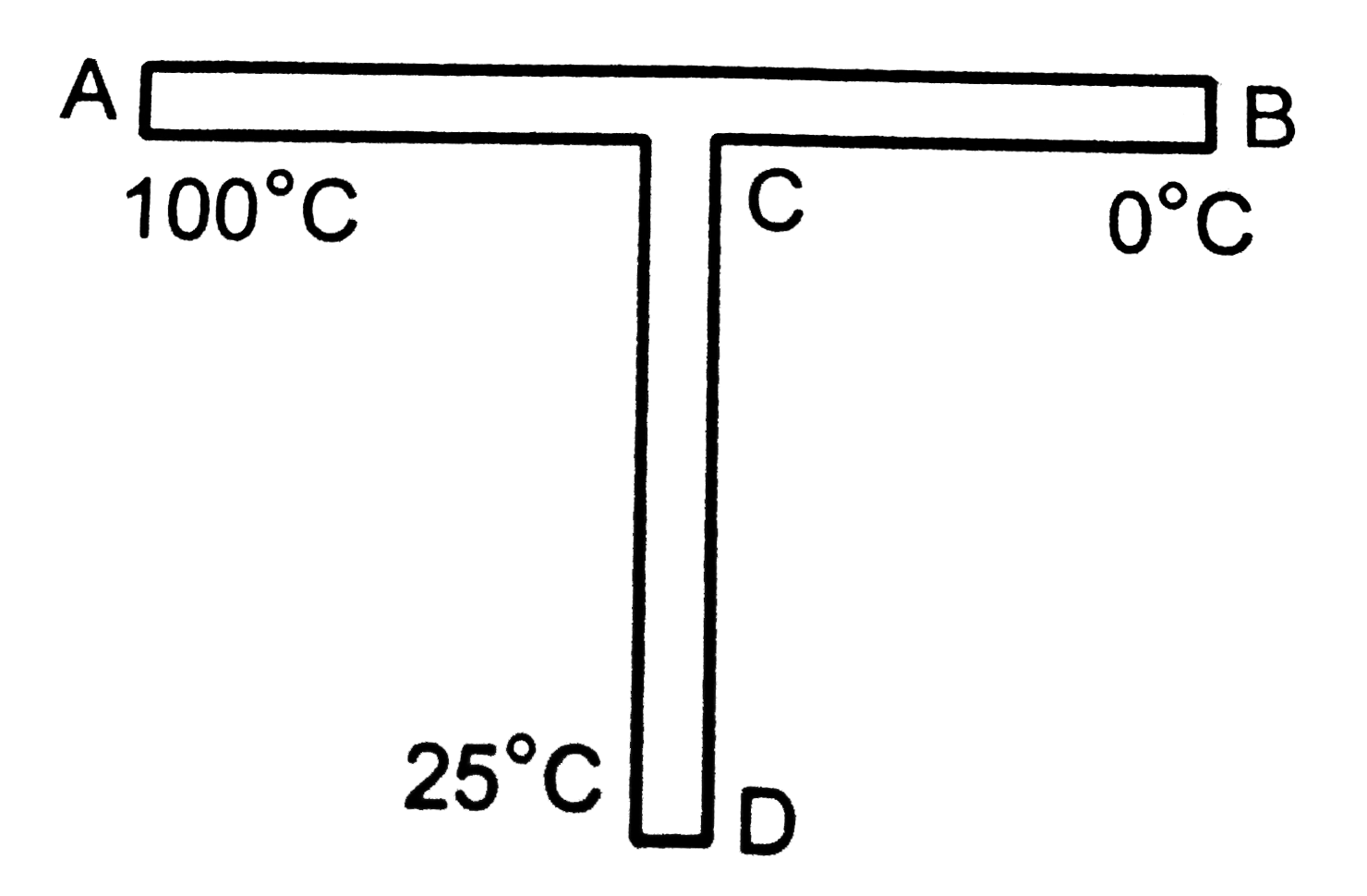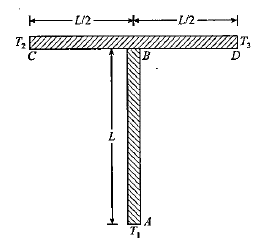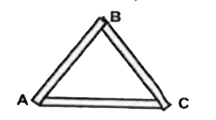Three liquid baths are thermally connected with the help of two identical rods AB and CD, each having thermal resistance 10C/W. There is a heater of 100W in the middle bath, the temperature of the left hand liquid bath is maintaind at 1000C and that of right hand side is maintained at 400C. Assume there is no heat loss to surroundings.
The steady temperature of the middle bath would be 1200C
The heat current in the left hand side rod would be 20W
The heat current in the right hand side rod would be 65 W
The heat current in the right hand side rod would be towards right
The correct Answer is:A, B, D
Topper's Solved these Questions
- TRANSMISSION OF HEATBOOK - AAKASH SERIESCHAPTER - TRANSMISSION OF HEATEXERCISE - LECTURE SHEET (EXERCISE-I) Thermal Conduction (Linked Comprehension Type Questions) Passage - II
3 Videos
- TRANSMISSION OF HEATBOOK - AAKASH SERIESCHAPTER - TRANSMISSION OF HEATEXERCISE - LECTURE SHEET (EXERCISE-I) Thermal Conduction (Integer Type Questions)
5 Videos
- TRANSMISSION OF HEATBOOK - AAKASH SERIESCHAPTER - TRANSMISSION OF HEATEXERCISE - ADDITIONAL PRACTICE EXERCISE (PRACTICE SHEET (ADVANCED)) (Integer/Subjective Type Questions)
3 Videos
- TRANSMISSION OF HEAT BOOK - AAKASH SERIESCHAPTER - TRANSMISSION OF HEAT EXERCISE - QUESTION FOR DESCRIPTIVE ANSWER
4 Videos
- UNITS AND MEASUREMENTBOOK - AAKASH SERIESCHAPTER - UNITS AND MEASUREMENTEXERCISE - Practice Exercise
45 Videos
Similar Questions
A rod CD of thermal resistance 5.0KW−1isjo∈edatthem≤ofannticalrodABasshown∈figure.TheendsA,BandDarema∫a∈edat100^(@)C,0(@)C and 25(@)C respectively. Find the heat current in CD.

View SolutionA rod CD of thermal resistance 5.0KW−1 is joined at the middle of an identical rod AB as shown in figure. The ends A, B and D are maintained at 100∘C , 0∘C and 25∘C respectively. Find the heat current in CD.

View Solution
Knowledge Check
A cylindrical steel rod of length 0.10 m and thermal conductivity 50W.m−1K−1 is welded end to end to copper rod of thermal conductivity 400W.m−1.K−1 and of the same area of cross section but 0.20 m long. The free end of the steel rod is maintained at 100∘C and that of the copper and at 0∘C. Assuming that the rods are perfectly insulated from the surrounding, the temperature at the junction of the two rods–
A20∘CB30∘CC40∘CD50∘CThe two ends of a metal rod are maintained at temperatures 100∘C and 110∘C . The rate of heat flow in the rod is found to be 4.0j/s. If the ends are maintaind at temperatures 200∘C and 210∘C, the rate of heat flow will be :
A16.8j/sB8.0j/sC4.0j/sD44.0j/sThe two ends of a metal rod are maintained at temperatures 100∘C and 110∘C . The rate of heat flow in the rod is found to be 4.0j/s. If the ends are maintaind at temperatures 200∘C and 210∘C, the rate of heat flow will be :
A16.8J/sB8.0J/sC4.0J/sD44.0J/s
A rod CD of thermal resistance 5.0KW−1 is joined at the middle of an identical rod AB as shown in figure. The ends A,B and D are maintained at 100∘C , 0∘C and 25∘C respectively. Find the heat current in CD.

View SolutionTwo identical rods AB and CD, each of length L are connected as shown in figure-4.22. Their cross-sectional area is A and their thermal conductivity is k. Ends A, C and D are maintained at temperatures T1,T2andT3 respectively. Neglecting heat loss to the surroundings, find the temperature at B.

View SolutionThree rods AB, BC and AC having thermal resistances of 10 units, 10 units and 20 units, respectively, are connected as shown in the figure. Ends A and C are maintained at constant temperatures of 100∘C and 0∘C, respectively. The rate at which the heat is crossing junction B is

View SolutionA rod of negligible heat capacity has length 40cm, area of cross-section 1.0cm2 and thermal conductivity 100Wm−1∘ C−1. The temperature of one end is maintained at 0o C and that of the other end is slowly and linearly varied 'from 0∘C to 60∘C in 10min. Assuming no loss of heat through the sides', find the total heat transmitted (in J) through the rod in these 10min.
View SolutionThree rods AB, BC and AC having thermal resistances of 10 units, 10 units and 20 units, respectively, are connected as shown in the figure. Ends A and C are maintained at constant temperatures of 100∘C and 0∘C, respectively. The rate at which the heat is crossing junction B is

View Solution
